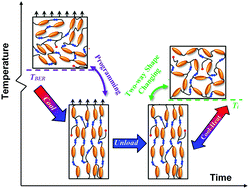当前位置:
X-MOL 学术
›
Soft Matter
›
论文详情
Our official English website, www.x-mol.net, welcomes your feedback! (Note: you will need to create a separate account there.)
Adaptable liquid crystal elastomers with transesterification-based bond exchange reactions†
Soft Matter ( IF 3.4 ) Pub Date : 2018-01-02 00:00:00 , DOI: 10.1039/c7sm02110k Drew W. Hanzon 1, 2, 3, 4 , Nicholas A. Traugutt 1, 2, 3, 4 , Matthew K. McBride 4, 5, 6, 7 , Christopher N. Bowman 4, 5, 6, 7 , Christopher M. Yakacki 1, 2, 3, 4 , Kai Yu 1, 2, 3, 4
Soft Matter ( IF 3.4 ) Pub Date : 2018-01-02 00:00:00 , DOI: 10.1039/c7sm02110k Drew W. Hanzon 1, 2, 3, 4 , Nicholas A. Traugutt 1, 2, 3, 4 , Matthew K. McBride 4, 5, 6, 7 , Christopher N. Bowman 4, 5, 6, 7 , Christopher M. Yakacki 1, 2, 3, 4 , Kai Yu 1, 2, 3, 4
Affiliation

|
Adaptable liquid crystal elastomers (LCEs) have recently emerged to provide a new and robust method to program monodomain LCE samples. When a constant stress is applied with active bond exchange reactions (BERs), polymer chains and mesogens gradually align in the strain direction. Mesogen alignment is maintained after removing the BER stimulus (e.g. by lowering the temperature) and the programmed LCE samples exhibit free-standing two-way shape switching behavior. Here, a new adaptable main-chain LCE system was developed with thermally induced transesterification BERs. The network combines the conventional properties of LCEs, such as an isotropic phase transition and soft elasticity, with the dynamic features of adaptable network polymers, which are malleable to stress relaxation due to the BERs. Polarized Fourier transform infrared measurements confirmed the alignment of polymer chains and mesogens after strain-induced programming. The influence of the creep stress, temperature, and time on the strain amplitude of two-way shape switching was examined. The LCE network demonstrates an innovative feature of reprogrammability, where the reversible shape-switching memory of programmed LCEs is readily deleted by free-standing heating as random BERs disrupt the mesogen alignment, so LCEs are reprogrammed after returning to the polydomain state. Due to the dynamic nature of the LCE network, it also exhibits a surface welding effect and can be fully dissolved in the organic solvent, which might be utilized for green and sustainable recycling of LCEs.
中文翻译:

具有基于酯交换的键交换反应的适应性液晶弹性体†
自适应液晶弹性体(LCE)最近出现,为编程单畴LCE样品提供了一种新的且健壮的方法。当通过主动键交换反应(BER)施加恒定应力时,聚合物链和液晶元会在应变方向上逐渐对齐。消除BER刺激后,保持了液晶元的排列(例如通过降低温度),已编程的LCE样品表现出独立的双向形状转换行为。在这里,开发了一种新的具有适应性的主链LCE系统,该系统具有热诱导的酯交换BER。该网络将LCE的常规特性(如各向同性相变和软弹性)与可适应的网络聚合物的动态特性相结合,这些特性可延展由于BER引起的应力松弛。偏振傅立叶变换红外测量结果证实了应变诱导编程后聚合物链和液晶元的排列。研究了蠕变应力,温度和时间对双向形状转换的应变幅度的影响。LCE网络展示了可重编程性的创新功能,其中,由于随机BER破坏了液晶元的排列,可通过独立加热轻易地删除已编程LCE的可逆形状转换记忆,因此LCE在返回多畴状态后将被重新编程。由于LCE网络的动态特性,它还表现出表面焊接效果,并且可以完全溶解在有机溶剂中,可用于绿色和可持续的LCE回收。
更新日期:2018-01-02
中文翻译:

具有基于酯交换的键交换反应的适应性液晶弹性体†
自适应液晶弹性体(LCE)最近出现,为编程单畴LCE样品提供了一种新的且健壮的方法。当通过主动键交换反应(BER)施加恒定应力时,聚合物链和液晶元会在应变方向上逐渐对齐。消除BER刺激后,保持了液晶元的排列(例如通过降低温度),已编程的LCE样品表现出独立的双向形状转换行为。在这里,开发了一种新的具有适应性的主链LCE系统,该系统具有热诱导的酯交换BER。该网络将LCE的常规特性(如各向同性相变和软弹性)与可适应的网络聚合物的动态特性相结合,这些特性可延展由于BER引起的应力松弛。偏振傅立叶变换红外测量结果证实了应变诱导编程后聚合物链和液晶元的排列。研究了蠕变应力,温度和时间对双向形状转换的应变幅度的影响。LCE网络展示了可重编程性的创新功能,其中,由于随机BER破坏了液晶元的排列,可通过独立加热轻易地删除已编程LCE的可逆形状转换记忆,因此LCE在返回多畴状态后将被重新编程。由于LCE网络的动态特性,它还表现出表面焊接效果,并且可以完全溶解在有机溶剂中,可用于绿色和可持续的LCE回收。



























 京公网安备 11010802027423号
京公网安备 11010802027423号